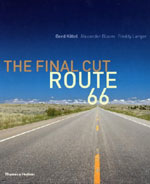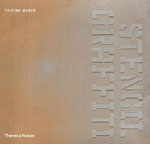Get Your Kicks... | |

| There are few, if any, highways in the world as (in)famous as Route 66. As much a part of a global mythology as it is a part of American history, Route 66 continues to hold an almost ghostly appeal to anyone with even a passing interest in popular culture and the uniquely American heroic epic of the road trip. The more so now that it's impossible to travel the original route, now that it is physically as well as culturally a part of a past that sinks further and further from view with each passing breath. What's interesting about the mythology of Route 66, as captured in The Final Cut - Route 66 (Gerd Kittel, Alexander Bloom and Freddy Langer - Thames and Hudson £19.95 ) is the alternative tale it seems to tell of both America past, and America present. It's a tale that casts the past in a strange gaudy light that is both enduringly appealing and vaguely repulsive; a present that is tired and faded, a land of ignored towns and long forgotten people. It's a tale of movement, of passage, of hitting and missing and strangely also of stagnation, of intransigence or at least disinterest in 'progress'. It's a tale told admirably by Gerd Kittel's glorious photographs and by Freddy Langer's detailed text. Whilst the text ably documents both the factual history of the road and, more vitally, the memories and observations of its travellers and those who still inhabit the route, like ghosts awaiting their final rest, it's Kittel's photographs that really capture the essence of the story. They are filled with wonder, sadness, humour, desolation, hopes turned sour and hope eternally flaming in spite of it all. They are fragments of lives echoing pasts through the present and into futures, looping themselves in some lost moment, longing for peace. Or, like the bizarre sight of 'Jesse James hideout' erected like Santa's grotto in the Meramac Caves, Stanton, Missouri, for a return of raucous life. It's never entirely sure which. There's a great mixture of details, people and landscape in the photographs, and in each there are those that are decayed, forgotten, lost, and also their inverse; the ones either grimly hanging on, or reinvented as historical documents, like some episode of Happy Days made concrete. Of course you'll have your own favourites, but a few of mine are the ladies in the Golden Rule shoe store in Galena, Kansas, where the shoes might be new(ish), but the setting most assuredly isn't, being filled with fading signs proclaiming eternal sales, and a five dollar charge for bad checks. The linoleum on the floor is peeled away, and the tape dispenser looks right out of the thirties. It's a great picture. As is the photo of Commerce, Oklahoma, which has a main street that looks like it could be right out of a Western movie, if it weren't for the tarmac on the road and the huge sings that read 'Karate' outside what looks like about the only store still in business. It's all slightly surreal. As is the sight of a decaying white building that one can only guess might have been once a diner or a garage, now lost in the midst of undergrowth at Glenrio, Texas. Or the lonely pumps of the bizarrely named Monte Carlo Truck Stop, near Ash Fork, Arizona. I could go on for hours, because there are plenty more fantastic photographs here, plenty more stories to be told or imagined, full of both marvellous positivism and desolate ache. Which really is the appeal of Route 66 all over; it's a depository for imaginations and memories, depending on your age and inclinations; a place for dreaming and reflection. And The Final Cut- Route 66 is a fine companion. |

| There have been a lot of books documenting urban street art in recent years, most of them focusing on the kind of 'piece' graffiti work that grew out of the New York scene of the mid '70s to '80s. Some are great, and, like the graffiti work itself, some aren't. One that is very fine, and that focuses instead on the specifics of the stencil genre of urban art, is Tristan Manco's Stencil Grafitti (Thames and Hudson, £9.95). Manco is himself a practising stencil artist and has been documenting examples from around the world's streets for the past fifteen years. Over 400 of those examples are collected in this book, and there's much to look at. From anonymous anti-capitalist protest works and Shephard Fairey's 'Andre the Giant' and 'Obey' pieces (with a nod to Jenny Holzer) to Thomas Baumgaertel's banana paintings (with more than a nod to Warhol/VU); through Bansky's fabulous ape motif pieces from around London to Pablo Fiasco's amazingly detailed typewriters and a host of points in between, this collection is frequently delightful, insightful and provocative. At its best, to quote artist Nylon, stencil graffiti breathes 'life into derelict spaces', and also integrates the image within 'the texture of the street' (Shephard Fairey), bringing together cultures in the cracks between the homogeny of the mass mediated society. For anyone with an interest in design, or in urban culture, this book is an essential read. |

| Equally essential for anyone interested in design is the Little Book Of Design Classics by Catherine McDermott (Carlton Books - £5.99). Whilst 'Little' is most assuredly the case here, at 112 pages, this tiny tome nevertheless packs a great punch, cramming in just over one hundred examples of 20th Century artefacts ranging from products to graphics to architecture and furniture. And whilst it's all pretty safe ground, the nature of such things means that the choice of designs will no doubt generate a good few arguments between aficionados over the merits of the various inclusions or exclusions. For me, it's a delight to see The Face included, even if it does make me feel my age, whilst the inclusion of the Dutch post Office Graphics from 1934 shows a quirky willingness to not simply tread the beaten, obvious paths. Naturally though, when making such collections, the nearer in time one comes to the 'present day', the harder it gets to choose what to highlight as 'classic'. Without the benefit of hindsight, after all, it's very difficult to gauge what will stand the test of critical judgement. As a result, it feels odd that the final 'classic' should be the Eden Project, a design whose photograph here looks oddly out of place. Because next to the often beautifully formed objects that pepper much of the rest of the book, the Eden biomes look a bit, well, dull and uninspired. However, that one disagreement aside, the Little Book of Design Classics is a great little volume that at six quid would make for a lovely addition to any desktop. © Alistair Fitchett 2002 |